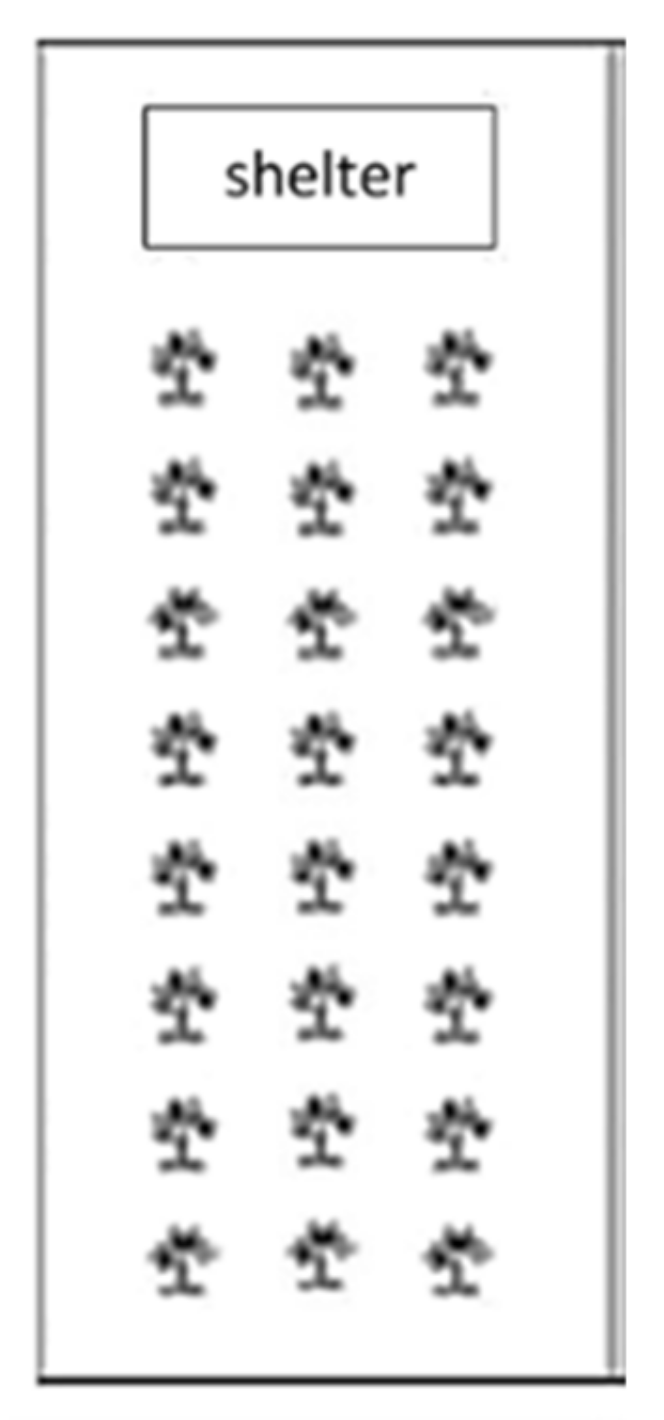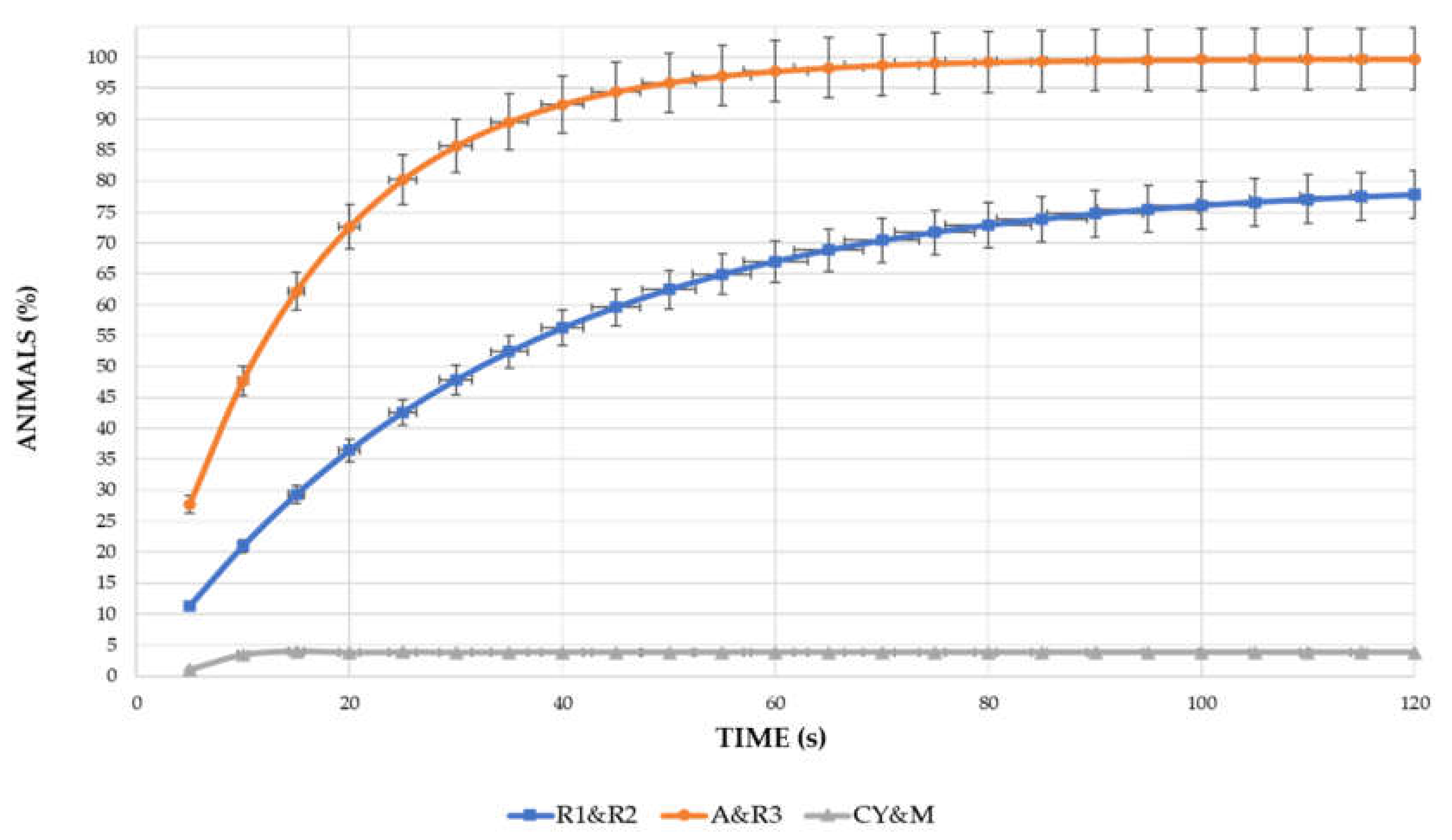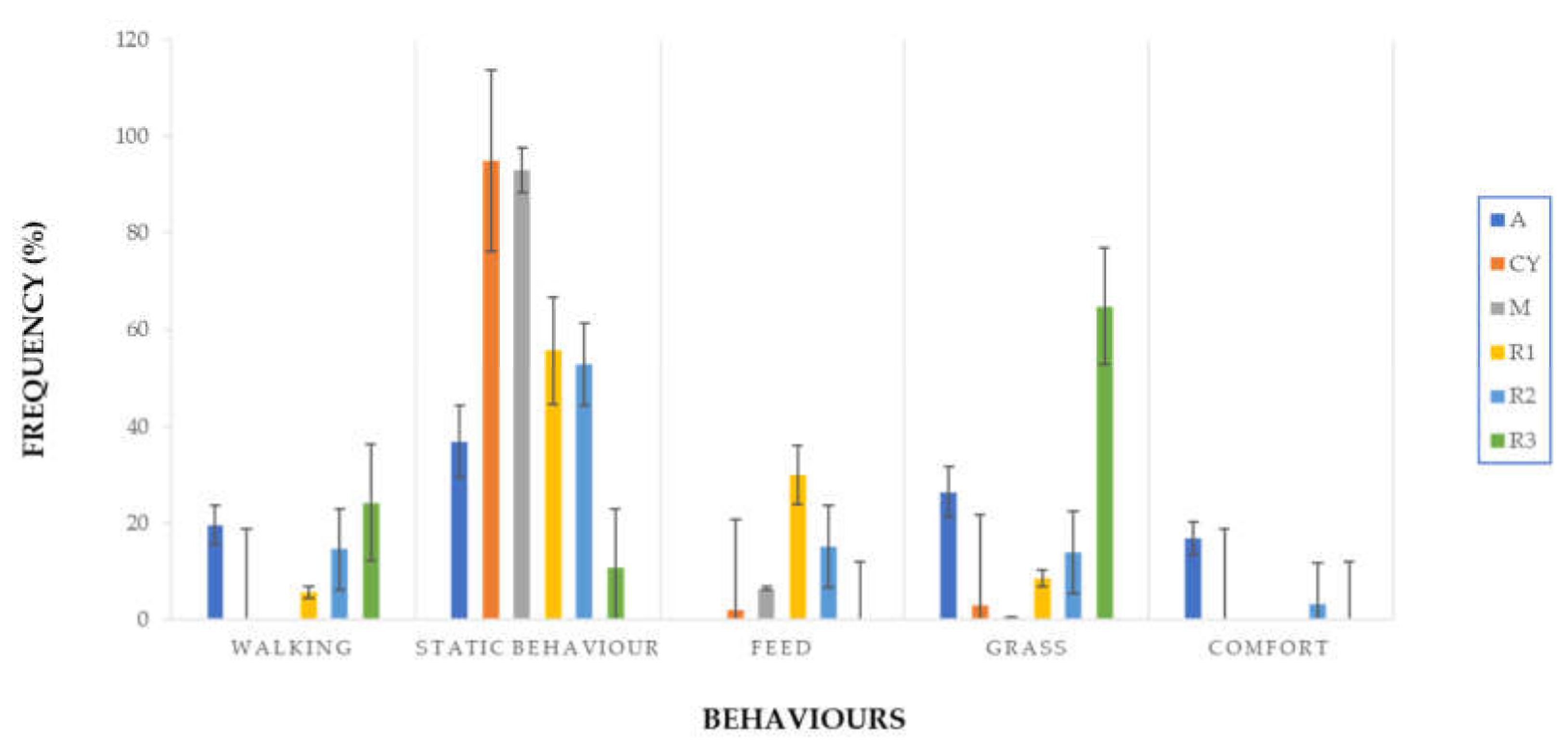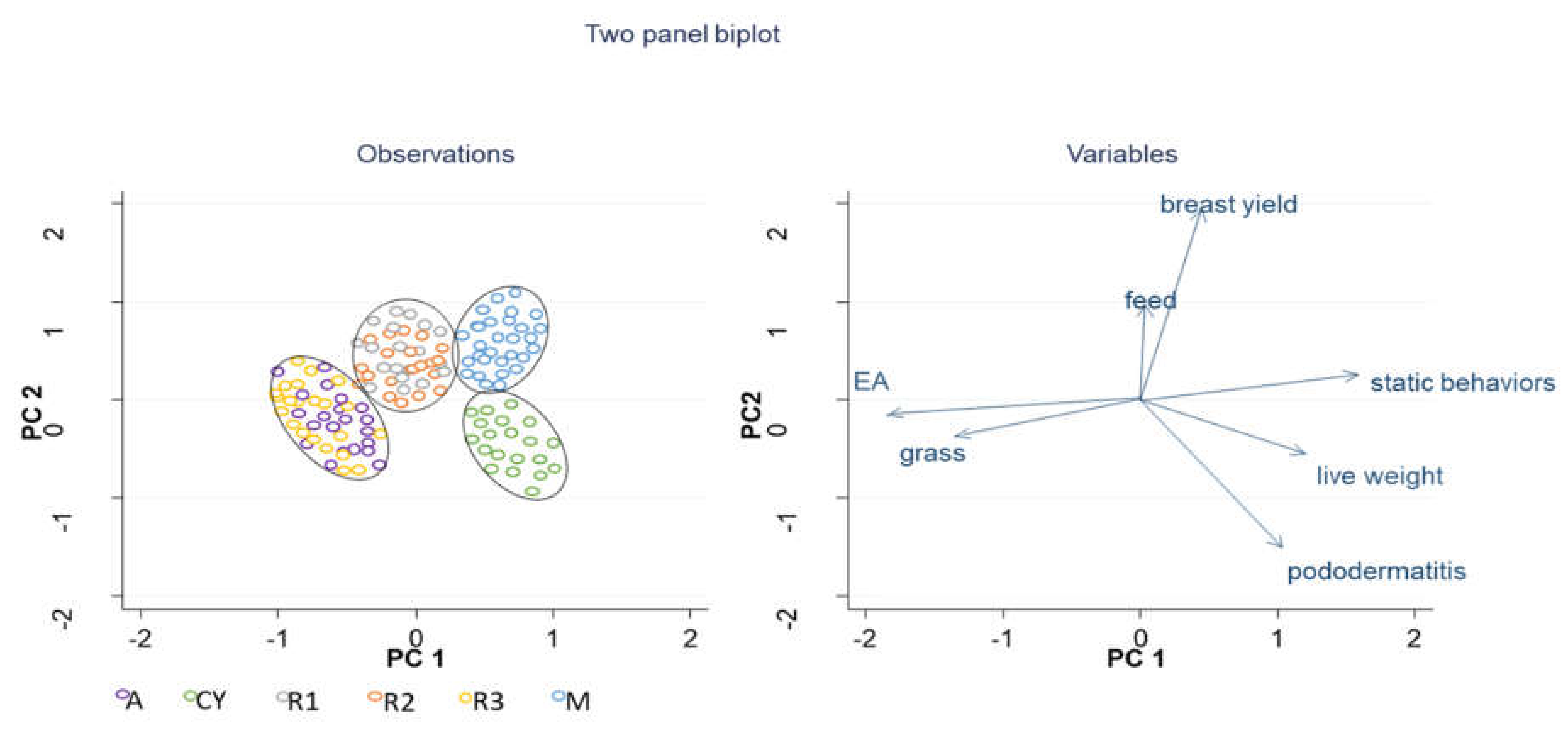Performance, Behavior, and Welfare Status of Six Different Organically Reared Poultry Genotypes
Abstract
:Simple Summary
Abstract
1. Introduction
- Fast-Growing (FG) strains, adapted to intensive rearing systems, and able to reach slaughter weight in a short time (about 2.5 kg in 40 d) with very high breast yield;
- Slow-Growing (SG) strains, which represent a heterogeneous group of chickens made up of commercial strains selected by poultry companies for outdoor farming and by local poultry breeds. These are not competitive as meat-type birds.
2. Materials and Methods
2.1. Birds and Farming Systems
- Aviagen: Ranger Classic (R1), Ranger Gold (R2), Rowan Ranger (R3);
- Hubbard: Hubbard RedJA (A), CY Gen 5 × JA87 (CY), M22 × JA87 (M).
2.2. Carcass Traits
2.3. Behavior Observation
2.4. Plumage Condition, Hock Burns and Footpad Dermatitis
2.5. Statistical Analysis
3. Results
3.1. Productive Performance
3.2. Behavior Observations
3.3. Plumage Conditions, Pododermatitis, and Sternal Lesions
3.4. Principal Component Analysis
4. Discussion
5. Conclusions
Author Contributions
Funding
Acknowledgments
Conflicts of Interest
References
- Castellini, C.; Dal Bosco, A.; Mugnai, C.; Bernardini, M. Performance and behaviour of chickens with different growing rate reared according to the organic system. Ital. J. Anim. Sci. 2003, 6, 561–573. [Google Scholar] [CrossRef]
- Castellini, C.; Dal Bosco, A.; Mugnai, C.; Pedrazzoli, M. Comparison of two chicken genotypes organically reared: Oxidative stability and other qualitative traits of the meat. Ital. J. Anim. Sci. 2006, 5, 29–42. [Google Scholar] [CrossRef]
- Dal Bosco, A.; Mugnai, C.; Amato, M.G.; Piottoli, L.; Cartoni, A.; Castellini, C. Effect of slaughtering age in different commercial chicken genotypes reared according to the organic system: 1. Welfare, carcass and meat traits. Ital. J. Anim. Sci. 2014, 13, 3308. [Google Scholar] [CrossRef] [Green Version]
- Canogulları, S.; Baylan, M.; Bulancak, A.; Ayaşan, T. Differences in performance, carcass characteristics and meat quality between fast- and slow-growing broiler genotypes. Prog. Nutr. 2019, 21, 558–565. [Google Scholar] [CrossRef]
- Mikulski, D.; Celej, J.; Jankowski, J.; Majewska, T.; Mikulska, M. Growth performance, carcass traits and meat quality of slower-growing and fast-growing chickens raised with and without outdoor access. Asian-Australas J. Anim. Sci. 2011, 24, 1407–1416. [Google Scholar] [CrossRef]
- Dal Bosco, A.; Mugnai, C.; Mattioli, S.; Rosati, A.; Ruggeri, S.; Ranucci, D.; Castellini, C. Transfer of bioactive compounds from pasture to meat in organic free-range chickens. Poult. Sci. 2016, 95, 2464–2471. [Google Scholar] [CrossRef] [PubMed]
- Ponte, P.I.P.; Alves, S.P.; Bessa, R.J.B.; Ferreira, L.M.A.; Gama, L.T.; Bras, J.L.A.; Fontes, C.M.; Prates, J.A.M. Influence of pasture intake on the fatty acid composition, and cholesterol, tocopherols, and tocotrienols content in meat from free-range broilers. Poult. Sci. 2008, 87, 80–88. [Google Scholar] [CrossRef]
- Cartoni Mancinelli, A.; Mattioli, S.; Dal Bosco, A.; Piottoli, L.; Ranucci, D.; Branciari, R.; Cotozzolo, E.; Castellini, C. Rearing Romagnola geese in vineyard: Pasture and antioxidant intake, performance, carcass and meat quality. Ital. J. Anim. Sci. 2019, 18, 372–380. [Google Scholar] [CrossRef] [Green Version]
- Mattioli, S.; Dal Bosco, A.; Ruggeri, S.; Martino, M.; Moscati, L.; Pesca, C.; Castellini, C. Adaptive response to exercise of fast-growing and slow-growing chicken strains: Blood oxidative status and non-enzymatic antioxidant defense. Poult. Sci. 2017, 96, 4096–4102. [Google Scholar] [CrossRef]
- Cömert, M.; Şayan, Y.; Kırkpınar, F.; Bayraktar, Ö.H.; Mert, S. Comparison of carcass characteristics, meat quality, and blood parameters of slow and fast grown female broiler chickens raised in organic or conventional production system. Asian-Australas J. Anim. Sci. 2016, 29, 987. [Google Scholar] [CrossRef] [Green Version]
- Castellini, C.; Mugnai, C.; Moscati, L.; Mattioli, S.; Guarino Amato, M.; Cartoni Mancinelli, A.; Dal Bosco, A. Adaptation to organic rearing system of eight different chicken genotypes: Behaviour, welfare and performance. Ital. J. Anim. Sci. 2016, 15, 37–46. [Google Scholar] [CrossRef]
- Broom, D.M. Indicators of poor welfare. Br. Vet. J. 1986, 142, 524–526. [Google Scholar] [CrossRef]
- Dal Bosco, A.; Cartoni Mancinelli, A.; Hoy, S.; Martino, M.; Mattioli, S.; Cotozzolo, E.; Castellini, C. Assessing the Preference of Rabbit Does to Social Contact or Seclusion: Results of Different Investigations. Animals 2020, 10, 286. [Google Scholar] [CrossRef] [PubMed] [Green Version]
- Dal Bosco, A.; Mugnai, C.; Martino, M.; Szendrő, Z.; Mattioli, S.; Cambiotti, V.; Cartoni Mancinelli, A.; Moscati, L.; Castellini, C. Housing rabbit does in a combi system with removable walls: Effect on behaviour and reproductive performance. Animals 2019, 9, 528. [Google Scholar] [CrossRef] [PubMed] [Green Version]
- Tauson, R. Plumage condition in SCWL laying hens kept in conventional cages of different designs. Acta Agric. Scand. 1984, 34, 221–230. [Google Scholar] [CrossRef]
- Berg, C. Foot-pad dermatitis in broilers and turkeys. Acta Univ. Agric. Sueciae Vet. 1998, 36, 7–43. [Google Scholar]
- Mitchell, M.N. Stata for the Behavioral Sciences; Stata Press: College Station, TX, USA, 2015. [Google Scholar]
- Bokkers, E.A.; Koene, P. Motivation and ability to walk for a food reward in fast-and slow-growing broilers to 12 weeks of age. Behav. Processes 2004, 67, 121–130. [Google Scholar] [CrossRef]
- Dal Bosco, A.; Mugnai, C.; Sirri, F.; Zamparini, C.; Castellini, C. Assessment of a global positioning system to evaluate activities of organic chickens at pasture. J. Appl. Poult. Res. 2010, 19, 213–218. [Google Scholar] [CrossRef]
- Kestin, S.C.; Gordon, S.; Su, G.; Sørensen, P. Relationships in broiler chickens between lameness, liveweight, growth rate and age. Vet. Rec. 2001, 148, 195–197. [Google Scholar] [CrossRef]
- Dal Bosco, A.; Mugnai, C.; Ruggeri, S.; Mattioli, S.; Castellini, C. Fatty acid composition of meat and estimated indices of lipid metabolism in different poultry genotypes reared under organic system. Poult. Sci. 2012, 91, 2039–2045. [Google Scholar] [CrossRef]
- Meluzzi, A.; Sirri, F.; Mugnai, C.; Dal Bosco, A. Effect of genotype on welfare conditions of broilers reared under organic conditions. In Proceedings of the 8th European Symposium on Poultry Welfare, Cervia, Italy, 18–22 May 2009. [Google Scholar]
- Souillard, R.; Répérant, J.M.; Experton, C.; Huneau-Salaun, A.; Coton, J.; Balaine, L.; Le Bouquin, S. Husbandry Practices, Health, and Welfare Status of Organic Broilers in France. Animals 2019, 3, 97. [Google Scholar] [CrossRef] [PubMed] [Green Version]
- Schütz, K.E.; Jensen, P. Effects of resource allocation on behavioural strategies: A comparison of red jungle fowl (Gallus gallus) and two domesticated breeds of poultry. Ethology 2001, 107, 753–765. [Google Scholar] [CrossRef]
- Van der Waaij, E.H. A resource allocation model describing consequences of artificial selection under metabolic stress. J. Anim. Sci. 2004, 82, 973–981. [Google Scholar] [CrossRef] [PubMed]
- Muir, W.M.; Craig, J.V. Improving animal well-being through genetic selection. Poult. Sci. 1998, 77, 1781–1788. [Google Scholar] [CrossRef] [PubMed]
- Arnould, C.; Faure, J.M. Use of pen space and activity of broiler chickens reared at two different densities. Appl. Anim. Behav. Sci. 2003, 84, 281–296. [Google Scholar] [CrossRef]
- Malchow, J.; Puppe, B.; Berk, J.; Schrader, L. Effects of elevated grids on growing male chickens differing in growth performance. Front. Vet. Sci. 2019, 6, 203. [Google Scholar] [CrossRef]
- Nortey, T.N.N.; Quarshie, E.A.; Owusu-Bremang, R.; Agyei-Henneh, E.; Frempong, N.S.; Stark, C.R. Effect of added dietary lysine and methionine above recommended levels, on growth performance, breast meat yield and financial returns in broilers. Ghana J. Agric. Sci. 2019, 54, 24–37. [Google Scholar] [CrossRef] [Green Version]
- Aftab, U. Energy and amino acid requirements of broiler chickens: Keeping pace with the genetic progress. Worlds Poult. Sci. J. 2019, 75, 507–514. [Google Scholar] [CrossRef]





| Behavior | Description |
|---|---|
| Activity | Active and Static behaviors |
| Static behaviors | Rest: body in line with the ground, with erect head and open eyes and Roost: stay in place standing, no body movement, head erect or relaxed with open eyes |
| Active behaviors | Walking: moving more than three steps in one direction with upright head |
| Eat | Activities linked to eating behavior |
| Feed | Consume feed |
| Grass | Consume grass |
| Comfort | Any behavior in which the animal expresses adaptation to the environment like stretching, grooming, etc. In these behaviors the animals assume a vulnerable position (i.e., head low, lying down, in a nonalert attitude). Indeed, animals do this when they are confident with the environment and are feeling safe. |
| Genotype | Units | A | CY | M | R1 | R2 | R3 | n/Genotype | Pooled SE/X2 |
|---|---|---|---|---|---|---|---|---|---|
| Live weight at slaughter | g | 3083.6 a | 3639.3 ab | 3405.0 ab | 3928.3 b | 3403.6 ab | 3022.1 a | 100 | 344.0 |
| Feed intake | g/d | 137.0 ab | 130.3 ab | 143.4 ab | 150.3 b | 130.3 ab | 141.8 a | 100 | 20.0 |
| Feed:gain ratio | 3.6 b | 2.9 a | 3.4 ab | 3.1 a | 3.1 a | 3.7 b | 100 | 1.0 | |
| Mortality | % (n) | 0.17 a (2) | 0.52 b (6) | 0.61 b (7) | 0.09 a (1) | 0.17 a (2) | 0.17 a (2) | 12 | 2.06 * |
| Breast yield | % | 18.8 a | 20.1 a | 28.1 b | 26.0 b | 22.7 a | 21.8 a | 10 | 2.5 |
| Muscle/bone | % | 2.5 | 2.7 | 2.5 | 3.0 | 2.6 | 2.7 | 10 | 0.2 |
| Strain | b1 | b2 | Upper 95%b1 | Lower 95%b1 | R2 | Root MSE |
|---|---|---|---|---|---|---|
| CY & M | 3.85 + 0.31 a | −0.88 + 0.03 | 2.5 | 4.3 | 89.9 | 1.89 |
| R1 & R2 | 78.11 + 9.22 b | 0.97 + 0.05 | 65.0 | 93.0 | 96.2 | 9.42 |
| A & R3 | 99.83 + 2.95 c | 0.94 + 0.05 | 94.0 | 103.0 | 98.8 | 9.44 |
| Genotypes | A | CY | M | R1 | R2 | R3 | X2 |
|---|---|---|---|---|---|---|---|
| Neck | 4.00 b | 2.75 a | 3.00 a | 3.71 b | 3.57 b | 3.71 b | 16.43 |
| Breast | 2.14 b | 1.71 ab | 1.25 a | 1.57 ab | 1.71 ab | 1.71 ab | 3.67 |
| Wings | 3.43 c | 2.25 ab | 2.00 a | 3.29 bc | 3.57 c | 3.29 bc | 16.56 |
| Back | 4.00 b | 3.00 a | 3.25 a | 4.00 b | 4.00 b | 3.71 b | 27.17 |
| Tail | 3.43 b | 1.75 a | 2.50 a | 3.43 b | 3.43 b | 3.14 b | 13.85 |
| Pododermatitis | 0.00 a | 2.00 b | 1.25 a | 1.43 a | 0.43 a | 0.14 a | 13.83 |
| Sternal lesions | 0.00 a | 0.70 b | 0.85 b | 0.34 ab | 0.14 ab | 0.2 ab | 3.07 |
| Trait | PC1 | PC2 |
|---|---|---|
| Static behavior | 0.51 | 0.07 |
| Live weight | 0.39 | −0.19 |
| Pododermatitis | 0.31 | −0.52 |
| Breast yield | 0.14 | 0.68 |
| Feed | 0.01 | 0.47 |
| Grass | −0.45 | −0.17 |
| EA | −0.52 | −0.08 |
| Eigen value | 3.03 | 1.36 |
| % Variance explained | 43.19 | 19.73 |
| Cumulative variance explained | 62.92 | |
© 2020 by the authors. Licensee MDPI, Basel, Switzerland. This article is an open access article distributed under the terms and conditions of the Creative Commons Attribution (CC BY) license (http://creativecommons.org/licenses/by/4.0/).
Share and Cite
Cartoni Mancinelli, A.; Mattioli, S.; Dal Bosco, A.; Aliberti, A.; Guarino Amato, M.; Castellini, C. Performance, Behavior, and Welfare Status of Six Different Organically Reared Poultry Genotypes. Animals 2020, 10, 550. https://doi.org/10.3390/ani10040550
Cartoni Mancinelli A, Mattioli S, Dal Bosco A, Aliberti A, Guarino Amato M, Castellini C. Performance, Behavior, and Welfare Status of Six Different Organically Reared Poultry Genotypes. Animals. 2020; 10(4):550. https://doi.org/10.3390/ani10040550
Chicago/Turabian StyleCartoni Mancinelli, Alice, Simona Mattioli, Alessandro Dal Bosco, Andrea Aliberti, Monica Guarino Amato, and Cesare Castellini. 2020. "Performance, Behavior, and Welfare Status of Six Different Organically Reared Poultry Genotypes" Animals 10, no. 4: 550. https://doi.org/10.3390/ani10040550
APA StyleCartoni Mancinelli, A., Mattioli, S., Dal Bosco, A., Aliberti, A., Guarino Amato, M., & Castellini, C. (2020). Performance, Behavior, and Welfare Status of Six Different Organically Reared Poultry Genotypes. Animals, 10(4), 550. https://doi.org/10.3390/ani10040550








